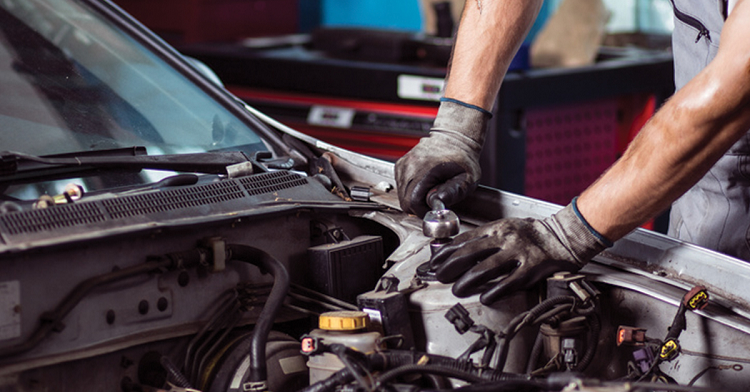Do you remember the last time that your coolant was changed? If it has been over two years since you flushed your radiator, you need to schedule a radiator flush immediately. In order to better understand why this is important, the following information will provide a basic overview that covers the anatomy of the cooling system and the steps involved in a flush.
Cooling System Components
The vehicle’s cooling system is made of several components. These components include the water pump, thermostat, heater, engine oil cooler, and the radiator. In addition, a number of clamps, hoses, and outlets support the major parts. Today’s engines are made of aluminium and therefore require protection against corrosion in order to run. That is why a coolant is necessary. Coolants are made with a mix of propylene glycol or ethylene and water.
Flush Your Radiator to Avoid an Expensive Repair
All coolants that are used for keeping the engine cool and operational contain inhibitors that prevent rust. However, when certain parts in the cooling system do not function, the passages in the radiator and engine become vulnerable to rust. An old coolant can also lead to overheating, which can trigger a number of expensive repairs. That is why you need to flush your radiator on a routine basis. Otherwise, the need for an expensive, if not debilitating, engine replacement can result.
Usual Coolant Colours
The colour of a coolant will give you an indication as to longevity. For instance, a red or green coolant or antifreeze lasts for a two-year period whilst orange coolants last longer. Regardless of the coolant use, never mix one colour with another hue.
Adding Coolant
If you read the owner’s manual for your car, it will indicate when you should flush your radiator. In the interim, you need to check the cooling system on your own. Always make a check when the engine has not been running or is cold. Never touch a radiator when it is hot. Add new coolant only when necessary.
Performing a Radiator Flush
To perform a radiator flush, a
Do you remember the last time that your coolant was changed? If it has been over two years since you flushed your radiator, you need to schedule a radiator flush immediately. In order to better understand why this is important, the following information will provide a basic overview that covers the anatomy of the cooling system and the steps involved in a flush.
Cooling System Components
The vehicle’s cooling system is made of several components. These components include the water pump, thermostat, heater, engine oil cooler, and the radiator. In addition, a number of clamps, hoses, and outlets support the major parts. Today’s engines are made of aluminium and therefore require protection against corrosion in order to run. That is why a coolant is necessary. Coolants are made with a mix of propylene glycol or ethylene and water.
Flush Your Radiator to Avoid an Expensive Repair
All coolants that are used for keeping the engine cool and operational contain inhibitors that prevent rust. However, when certain parts in the cooling system do not function, the passages in the radiator and engine become vulnerable to rust. An old coolant can also lead to overheating, which can trigger a number of expensive repairs. That is why you need to flush your radiator on a routine basis. Otherwise, the need for an expensive, if not debilitating, engine replacement can result.
Usual Coolant Colours
The colour of a coolant will give you an indication as to longevity. For instance, a red or green coolant or antifreeze lasts for a two-year period whilst orange coolants last longer. Regardless of the coolant use, never mix one colour with another hue.
Adding Coolant
If you read the owner’s manual for your car, it will indicate when you should flush your radiator. In the interim, you need to check the cooling system on your own. Always make a check when the engine has not been running or is cold. Never touch a radiator when it is hot. Add new coolant only when necessary.
Performing a Radiator Flush
To perform a radiator flush, a Brookvale mechanic first drains the old antifreeze. The tools that are used to perform the work include a drain pan, gloves, protective eyewear, and towels. An oil-absorbent material is kept on hand in case of spillage. To initiate the flush, a cleaner and water mix is used to eliminate corrosive buildup and rust.
After the flush is performed, the cooling system is filled with a mixture of water and coolant that is made of 50% to 70% antifreeze and 30% to 50% water. A funnel is used to add the coolant mix and an antifreeze tester checks the blend.
The mechanic may determine that the hoses and clamps may need replacement during a flush. These accessories are not replaced until the old coolant is flushed or removed from the system and new coolant is added. Whilst flushing a radiator does not involve much time, it can be easily forgotten if maintenance is not regularly scheduled by a vehicle owner. If your car has not had this service for some time, again, it is time to see a mechanic.
. The tools that are used to perform the work include a drain pan, gloves, protective eyewear, and towels. An oil-absorbent material is kept on hand in case of spillage. To initiate the flush, a cleaner and water mix is used to eliminate corrosive buildup and rust.
After the flush is performed, the cooling system is filled with a mixture of water and coolant that is made of 50% to 70% antifreeze and 30% to 50% water. A funnel is used to add the coolant mix and an antifreeze tester checks the blend.
The mechanic may determine that the hoses and clamps may need replacement during a flush. These accessories are not replaced until the old coolant is flushed or removed from the system and new coolant is added. Whilst flushing a radiator does not involve much time, it can be easily forgotten if maintenance is not regularly scheduled by a vehicle owner. If your car has not had this service for some time, again, it is time to see a mechanic.









